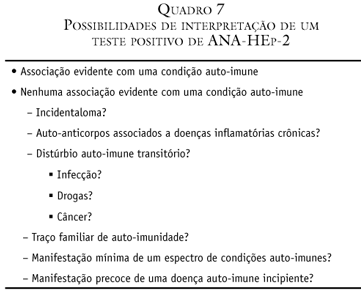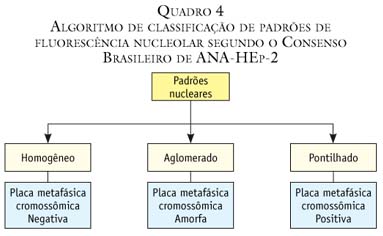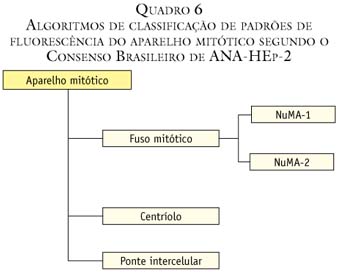Due to its continuous evolving process the fluorescent antinuclear antibody test (ANA-HEp-2) has required constant update efforts from personal involved in performing and interpreting its results. The methodological advances have brought up a considerable improvement in the test's sensitivity and consequently a decrease in its specificity. This has resulted in an increasing number of positive tests in apparently healthy subjects. This fact contributes to embarrassing situations and implies in the necessity to seek for elements to help the involved professionals. Well-conducted studies and experience have shown that there are some peculiar features associated with the auto-antibodies in patients with autoimmune diseases that are not present in those observed in healthy subjects. The present review brings an approach on the most important points to be considered in the analysis and evaluation of an ANA test that might help the identification of patients with autoimmune disease. Titer and immunofluorescence pattern are important parameters in the evaluation of the significance of a positive ANA-HEp2 test and in the reflex demand for further tests for specific autoantibodies. In general non-autoimmune individuals present low titer ANA-HEp-2 and patients with systemic autoimmune diseases present moder ate or high titer ANA-HEp-2 tests. However, exceptions to this are normally observed in both contexts. The homogeneous and coarse speckled nuclear patterns are almost exclusively observed in patients with systemic autoimmunity. On the other hand, the nuclear dense fine speckled pattern is one of the most frequently observed patterns in non-autoimmune individuals with a positive ANA-HEp-2 test. The basic concepts of the National Consensus on Standardization of ANA-HEp-2 Report have helped Brazilian rheumatologists and pathologists in the correct interpretation of the great diversity of ANA-HEp-2 immunofluorescence patterns. Finally, it is important to consider the possible and alternative significance of a positive ANA test in patients without objective evidence of autoimmune diseases.
antinuclear antibodies; HEp-2 cells; autoimmune diseases; autoantibodies












